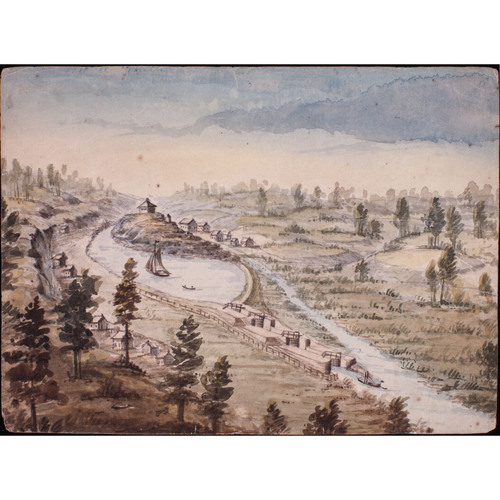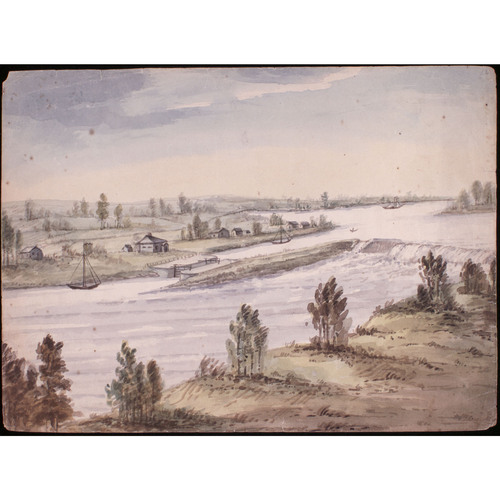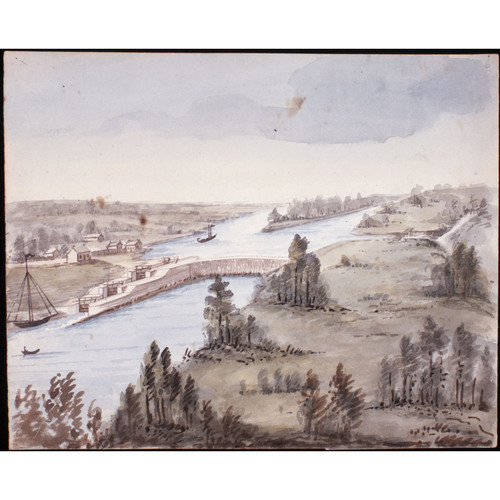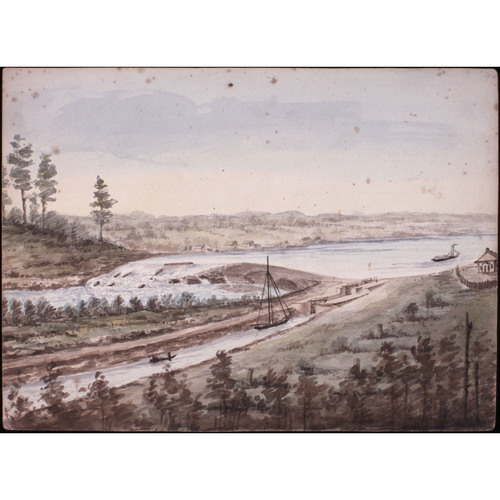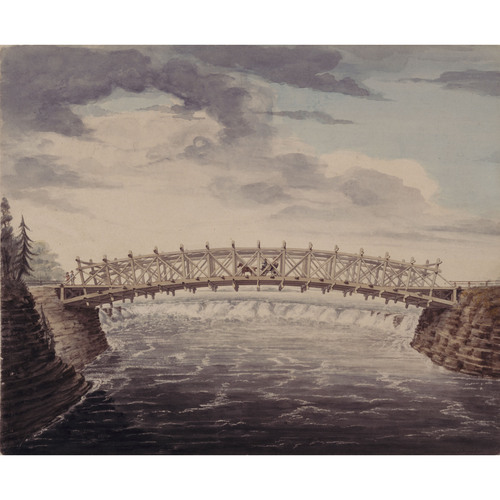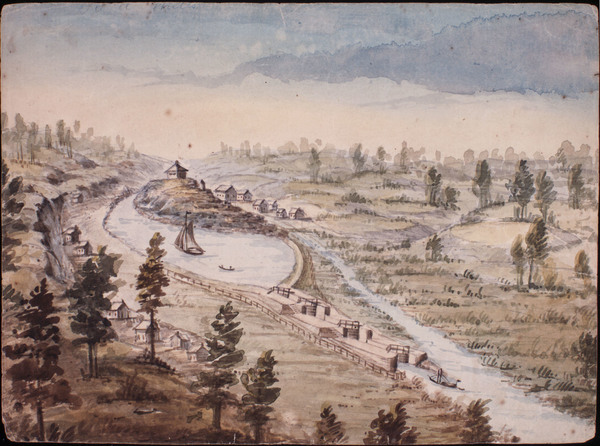
Source: Link
BURROWS, JOHN (originally named John Burrows Honey), surveyor, engineer, artist, and politician; b. 1 May 1789 possibly in the parish of Buckland Monachorum, near Plymouth, England, son of Christopher Honey and Elizabeth Burrows; m. first 7 June 1809 Ann Boden (Bowden) in the parish of Stoke Damerel (Plymouth); m. secondly 4 Feb. 1833 Maria Elizabeth Hoskin, née Blake; he had six sons and five daughters; d. 27 July 1848 in Kingston, Upper Canada.
John Burrows Honey first practised civil engineering in Plymouth. As well, while in England, he served in a militia unit, the Prince of Wales regiment. However, according to a grandnephew, William Thomas Rochester Preston*, he was forced to leave the country because of his political radicalism. In about 1815 he immigrated to the Canadas and settled in Nepean Township, Upper Canada. He apparently returned briefly to Plymouth but soon sailed back, arriving at Quebec on 20 Oct. 1817 and locating once again in Nepean, on the site of present-day Ottawa. Honey qualified as a land surveyor in Hull, Lower Canada, in December 1820. The following year he acquired title to 200 acres in Nepean, property which would increase greatly in value when the Rideau Canal was constructed through the lot, but he sold it, prematurely, in September 1821 for £95 to Nicholas Sparks*.
Honey made his name on the staff of Lieutenant-Colonel John By during the construction of the canal. Taken on as an overseer of works on 1 March 1827, he held a responsible post, assisting the Royal Engineers in the measurement and assessment of the work of the various contractors and in the certification of accounts. At about this time he changed his surname to Burrows, a step the one-time radical reputedly took to avoid detection in England. When John Mactaggart*, the clerk of works, was dismissed for misconduct in June 1828, By would have named Burrows to the post instead of Nicol Hugh Baird had he had more experience. As it was, Burrows had assumed Mactaggart’s duties on several occasions when he was ill disposed, and had acted as a draftsman and surveyor in the engineer department. In By’s words Burrows had rendered himself “extremely useful on all occasions.” It was not surprising therefore that, in early 1830, By recommended, though without success, that Burrows’s pay be raised from 7s. 6d. to 13s. per day, within 1s. of the top pay accorded the clerk of works. In 1832, following the canal’s completion, By without hesitation appointed Burrows to represent the crown before a jury investigating flood claims brought by landowners along the canal. That year he was also among the permanent appointees to the engineering staff of the British Ordnance department at Bytown (Ottawa).
Burrows had established himself as a leading citizen there soon after the commencement of the canal. From 1828 he served as a town councillor, and was nominated to council as late as 1847. In 1833 he married for the second time, and letters indicate a devoted husband and father. An ardent Methodist, he built in 1827 the first chapel in Bytown, and when this burned, made his house available to the congregation pending the building of a new chapel. Although temperate in his habits, he could enjoy a glass of wine with his wife.
By February 1837 Burrows owned no fewer than 17 houses in Bytown, an indication that he had achieved some measure of prosperity. Writing to her sister in England that year, Maria Burrows described her husband’s health as poor; he had been confined to their house for most of the winter with rheumatism and lumbago. Despite failing health, Burrows continued as overseer of works in the Ordnance department’s engineering office until his death. In that position he executed a series of historically useful pencil and water-colour views of various lock-sites on the canal. He died on 27 July 1848, and was buried in Hull and later reburied in New Edinburgh (Ottawa).
Burrows’s service in the construction of the Rideau Canal, and his contribution to the community to which it gave rise, were considerable. His high principles and religious fervour were untainted by intolerance or Pharisaism.
John Burrows’s 1827 sketch-book or diary is in Ottawa, Hist. Soc., Bytown Museum and Arch. (Ottawa), JBUR; a photocopy of it is available at the PAC. The diary has been published in Sights and surveys: two diarists on the Rideau, ed. Edwin Welch (Ottawa, 1979). A number of Burrows’s pencil and water-colour sketches of the Rideau Canal are reproduced in R. W. Passfield, Building the Rideau Canal: a pictorial history (Don Mills [Toronto], 1982).
AO, MU 938, biog. information relating to John Burrows; RG 22, ser.155. PAC, MG 29, D106; RG 5, A1: 48488, 65430; RG 8, I (C ser.), 43: 236; 45: 236. PRO, WO 44/20: 65–68; 44/23: 249–52 (copies at PAC). Christian Guardian, 9 Aug., 4 Oct. 1848. Church, 17 Aug. 1848. Packet (Bytown [Ottawa]), 29 July 1848. Lucien Brault, Ottawa old & new (Ottawa, 1946). E. F. Bush, The builders of the Rideau Canal, 1826–32 (Can., National Hist. Parks and Sites Branch, Manuscript report, no.185, Ottawa, 1976), 89–93. Blodwen Davies, The charm of Ottawa . . . (Toronto, 1932). H. T. Douglas, “Bits and pieces, that’s all; ten thousand words concerning Ottawa and the Ottawa area” (typescript, [Ottawa], 1969; copy at Ottawa, Hist. Soc., Bytown Museum and Arch.). R. [F.] Legget, Rideau waterway (Toronto, 1955). H. [J. W.] and Olive [Moffatt] Walker, Carleton saga (Ottawa, 1968).
Cite This Article
E. F. Bush, “BURROWS, JOHN (John Burrows Honey),” in Dictionary of Canadian Biography, vol. 7, University of Toronto/Université Laval, 2003–, accessed December 20, 2025, https://www.biographi.ca/en/bio/burrows_john_7E.html.
The citation above shows the format for footnotes and endnotes according to the Chicago manual of style (16th edition). Information to be used in other citation formats:
| Permalink: | https://www.biographi.ca/en/bio/burrows_john_7E.html |
| Author of Article: | E. F. Bush |
| Title of Article: | BURROWS, JOHN (John Burrows Honey) |
| Publication Name: | Dictionary of Canadian Biography, vol. 7 |
| Publisher: | University of Toronto/Université Laval |
| Year of publication: | 1988 |
| Year of revision: | 1988 |
| Access Date: | December 20, 2025 |


